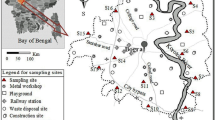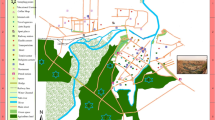Abstract
The objective of this study was to assess the contamination level of trace metals in soil and vegetables and health risk to the urban population in Bangladesh. The range of Cr, Ni, Cu, As, Cd, and Pb in agricultural soils was 158–1160, 104–443, 157–519, 41–93, 3.9–13, and 84–574 mg/kg, respectively. Sequential extraction tests revealed that the studied metals were predominantly associated with the residual fraction, followed by the organically bound phase. Concerning Cu, Ni, Cd, and Pb in vegetables, more than 50 % samples exceeded the FAO/WHO recommended permissible limits. Considering the transfer of metals from soil to vegetables, Cu and Cd exhibited higher transfer factor (TF) values than the other metals. Target hazard quotient (THQ) for individual metal was below 1, suggesting that people would not experience significant health hazards if they ingest a single metal from vegetables. However, total metal THQ signifies the potential non-carcinogenic health hazard to the highly exposed consumers. The carcinogenic risk (TR) of As (1.9 × 10−4) and Pb (2.3 × 10−5) through consumption of vegetables were higher than the USEPA threshold level (10−6), indicating potential cancer risks.




Similar content being viewed by others
References
Adeniyi, A. A., Yusuf, K. O., & Okedeyi, O. O. (2008). Assessment of the exposure of two fish species to metals pollution in the Ogun river catchments, Kettu, Lagos, Nigeria. Environmental Monitoring and Assessment, 137, 451–458.
Ahmad, J. U., & Goni, M. A. (2010). Heavy metal contamination in water, soil, and vegetables of the industrial areas in Dhaka, Bangladesh. Environmental Monitoring and Assessment, 166, 347–357.
Ahmad, S., Siddiqui, E. N., & Khalid, S. (1996). Studies on certain physico chemical properties of soil of two fresh water ponds of Darbhanga. Environmental Pollution, 31, 31–39.
Ahmed, F., Bibi, M. H., Asaeda, T., Mitchell, C. P. J., Ishiga, H., & Fukushima, T. (2012). Elemental composition of sediments in Lake Jinzai, Japan: assessment of sources and pollution. Environmental Monitoring and Assessment, 184, 4383–4396.
Ahmed, M. K., Kundu, G. K., Al-Mamun, M. H., & Islam, M. R. (2013). Impact of hexavalent chromium on histopathology in freshwater stinging Catfish, Heteropneustes fossilis. Research and Reviews: A Journal of Toxicology, 3, 1–8.
Chlopecka, A., Bacon, J. R., Wilson, M. J., & Kay, J. (1996). Forms of cadmium, lead and zinc in contaminated soils from southwest Poland. Journal of Environmental Quality, 25, 69–79.
FAO/WHO (2011). Joint FAO/WHO Food Standards programme Codex committee on contaminants in foods Food. CF/5 INF/1, pp 1–89.
Islam, M. S., Han, S., Ahmed, M. K., & Masunaga, S. (2014a). Assessment of trace metal contamination in water and sediment of some rivers in Bangladesh. Journal of Water and Environmental Technology, 12, 109–121.
Islam, M. S., Ahmed, M. K., & Al-Mamun, M. H. (2014b). Determination of heavy metals in fish and vegetables in Bangladesh and health implications. Human and Ecological Risk Assessment. An International Journal. doi:10.1080/10807039.2014.950172.
Kashem, M. A., & Singh, B. R. (1999). Heavy metal contamination of soil and vegetation in the vicinity of industries in Bangladesh. Water, Air, and Soil Pollution, 115, 347–361.
Kashem, M. A., Singh, B. R., & Shigenao, K. (2007). Mobility and distribution of cadmium, nickel and zinc in contaminated soil profiles from Bangladesh. Nutrient Cycling in Agroecosystems, 77, 187–198.
Khan, S., Cao, Q., Zheng, Y. M., Huang, Y. Z., & Zhu, Y. G. (2008). Health risks of heavy metals in contaminated soils and food crops irrigated with wastewater in Beijing, China. Environmental Pollution, 152, 686–692.
Khan, S., Rehman, S., Khan, A. Z., Khan, M. A., & Shah, M. T. (2010). Soil and vegetables enrichment with heavy metals from geological sources in Gilgit, Northern Pakistan. Ecotoxicology and Environmental Safety, 73, 1820–1827.
Li, Q. S., Chen, Y., Fu, H., Cui, Z., Shi, L., Wang, L., & Liu, Z. (2012). Health risk of heavy metals in food crops grown on reclaimed tidal flat soil in the Pearl River Estuary, China. Journal of Hazardous Materials, 227–228, 148–154.
Li, X., & Huang, C. (2007). Environment impact of heavy metals on urban soil in the vicinity of industrial area of Baoji City, P.R. China. Environmental Geology, 52, 1631–1637.
Luo, C., Liu, C., Wang, Y., Liu, X., Li, F., Zhang, G., & Li, X. (2011). Heavy metal contamination in soils and vegetables near an e-waste processing site, south China. Journal of Hazardous Materials, 186, 481–490.
Ming, C., & Ma, L. Q. (2001). Comparison of three aqua regia digestion methods for twenty Florida soils. Soil Science Society of America Journal, 65, 491–499.
Morillo, J., Usero, J., & Gracia, I. (2004). Heavy metal distribution in marine sediments from the southwest coast of Spain. Chemosphere, 55, 431–442.
Muchuweti, M., Birkett, J. W., Chinyanga, E., Zvauya, R., Scrimshaw, M. D., & Lister, J. N. (2006). Heavy metal content of vegetables irrigated with mixtures of wastewater and sewage sludge in Zimbabwe: implication for human health. Agriculture, Ecosystems & Environment, 112, 41–48.
Murray, K. S., Cauvet, D., Lybeer, M., & Thomas, J. C. (1999). Particle size and chemical control of heavy metals in bed sediment from the Rouge River, Southeast Michigan. Environmental Science and Technology, 33, 987–992.
Nath, K., Singh, D., Shyam, S., & Sharma, Y. K. (2009). Phytotoxic effects of chromium and tannery effluent on growth and metabolism of Phaseolus mungo Roxb. Journal of Environmental Biology, 30, 227–234.
Peris, M., Carolina, M., Luis, R., Raúl, S., & Juan, S. (2007). Heavy metal contents in horticultural crops of a representative area of the European Mediterranean Region. Science of the Total Environment, 378, 42–48.
Rahman, M. M., Asaduzzaman, M., & Naidu, R. (2013). Consumption of arsenic and other elements from vegetables and drinking water from an arsenic-contaminated area of Bangladesh. Journal of Hazardous Materials, 262, 1056–1063.
Rahman, S. H., Khanam, D., Adyel, T. M., Islam, M. S., Ahsan, M. A., & Akbor, M. A. (2012). Assessment of heavy metal contamination of agricultural soil around Dhaka export processing zone (DEPZ), Bangladesh, implication of seasonal variation and indices. Applied Sciences, 2, 584–601.
Sipter, E., Rózsa, E., Gruiz, K., Tátrai, E., & Morvai, V. (2008). Site-specific risk assessment in contaminated vegetable gardens. Chemosphere, 71, 1301–1307.
Srinivasa, G. S., Reddy, M. R., & Govil, P. K. (2010). Assessment of heavy metal contamination in soils at Jajmau (Kanpur) and Unnao industrial areas of the Ganga Plain, Uttar Pradesh, India. Journal of Hazardous Materials, 174, 113–121.
Szolnoki, Z., & Farsang, A. (2013). Evaluation of metal mobility and bioaccessibility in soils of urban vegetable gardens using sequential extraction. Water, Air, and Soil Pollution, 224, 1737–1752.
Tessier, A., Campbell, P. G. C., & Bisson, M. (1979). Sequential extraction procedures for the speciation of particulate trace metals. Analytical Chemistry, 51, 844–851.
Tiwari, K. K., Singh, N. K., Patel, M. P., Tiwari, M. R., & Rai, U. N. (2011). Metal contamination of soil and translocation in vegetables growing under industrial wastewater irrigated agricultural field of Vadodara, Gujarat, India. Ecotoxicology and Environmental Safety, 74, 1670–1677.
US Environmental Protection Agency (USEPA). (1989). Risk assessment guidance for superfund, vol. I: human health evaluation manual. EPA/540/1–89/002. Washington: Office of Emergency and Remedial Response.
US Environmental Protection Agency (USEPA) (2010). Risk-based Concentration Table Available from: http://www.epa.gov/reg3hwmd/risk/human/index.htm.
VROM (Volkshuisvesting, Ruimtelijke Ordening enMilieubeheer) (Ministry of Housing, Spatial Planning and Environment). (2000). Circular on target values and intervention values for soil remediation. Spatial planning and environment. Netherlands: Ministry of Housing.
Wang, W. H., Wong, M. H., Leharne, S., & Fisher, B. (1998). Fractionation and biotoxicity of heavy metals in urban dusts collected from Hong Kong and London. Environmental Geochemistry and Health, 20, 185–198.
Xu, D., Zhou, P., Zhan, J., Gao, Y., Dou, C., & Sun, Q. (2013). Assessment of trace metal bioavailability in garden soils and health risks via consumption of vegetables in the vicinity of Tongling mining area, China. Ecotoxicology and Environmental Safety, 90, 103–111.
Yap, D. W., Adezrian, J., Khairiah, J., Ismail, B. S., & Ahmad-Mahir, R. (2009). The uptake of heavy metals by paddy plants (Oryza sativa) in Kota Marudu, Sabah, Malaysia. American-Eurasian Journal of Agriculture and Environmental Science, 6, 16–19.
Zhao, L., Xu, Y., Hou, H., Shangguan, Y., & Li, F. (2014). Source identification and health risk assessment of metals in urban soils around the Tanggu chemical industrial district, Tianjin, China. Science of the Total Environment, 468–469, 654–662.
Acknowledgments
The authors are grateful for financial support for conducting this research from the Leadership Program in Sustainable Living with Environmental Risk (SLER) at Yokohama National University under the aid of Strategic Funds for the Promotion of Science and Technology from the Ministry of Education, Culture, Sports, Science and Technology and also for Research Collaboration Promotion Fund provided by Graduate School of Environment and Information Sciences, Yokohama National University, Japan. Furthermore, we are thankful for the kind help from the members of Dhaka University, Bangladesh during the field sampling.
Author information
Authors and Affiliations
Corresponding author
Electronic supplementary material
Below is the link to the electronic supplementary material.
ESM 1
(DOCX 14 kb)
Rights and permissions
About this article
Cite this article
Islam, M.S., Ahmed, M.K., Habibullah-Al-Mamun, M. et al. Trace metals in soil and vegetables and associated health risk assessment. Environ Monit Assess 186, 8727–8739 (2014). https://doi.org/10.1007/s10661-014-4040-y
Received:
Accepted:
Published:
Issue Date:
DOI: https://doi.org/10.1007/s10661-014-4040-y




